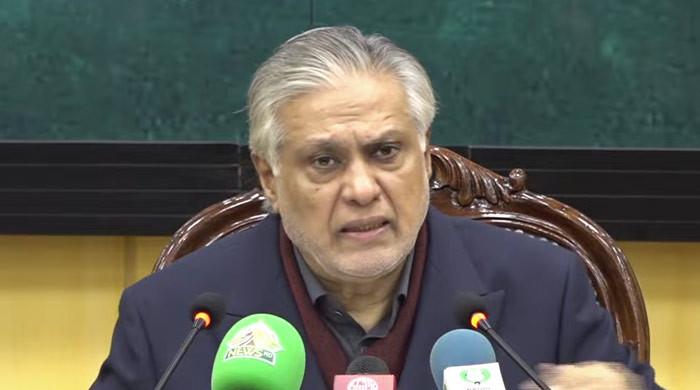Why is the load-shedding situation getting worse in Pakistan?
Power cuts continue in KP, Sindh and Balochistan as electricity shortfall touches 6,500 megawatts
June 10, 2021

- Power shortfall of 6,500 megawatts leads to load-shedding.
- This shortfall is despite Pakistan the fact that the country having a de-rated capacity to generate electricity up to 29,000 MW.
- Shortfall is primarily due to a decrease in supply of RLNG to power houses.
ISLAMABAD: Pakistanis continue to suffer load-shedding for several hours at a time amid intense temperatures as the country's electricity shortfall has reached 6,500 megawatts.
This shortfall is despite Pakistan the fact that the country having a de-rated capacity to generate electricity up to 29,000 MW. The shortfall is primarily due to a decrease in supply of RLNG to power houses.
On Wednesday, residents of Khyber Pakhtunkhwa, Sindh and Balochistan faced load-shedding of up to 20 hours when the mercury remained in the range of 41 to 46 degrees centigrade.
Read more: Unannounced load-shedding leaves Karachi citizens powerless
Less hydro generation of 3,300 MW because of the maintenance of turbines at the Tarbela Dam that lasted for six days added to the power cuts in South Punjab, particularly in DG Khan, senior official sources told The News.
The government has closed down its old Gencos and runs only Guddu and other power plants of 450 MW, which has made the situation worse, the sources said, adding that revenue based load-shedding of 5,500 MW has adversely hit the country.
The government, however, is conceding a power deficit of 1,500 MW only. If 1,500 MW is added with revenue based load-shedding of 5,500 MW, the total power deficit stands at 6,500 MW.
How bad is the load-shedding?
If there was a deficit of 800 MW, countrywide load-shedding should stand at one hour, the sources said. But since the power deficit now stands at 6,500 MW, the load-shedding goes up to 7-8 hours.
However, since power cuts are not being carried out across the whole country, people in KP, Sindh and Balochistan and some areas of South Punjab are badly suffering from load-shedding of 4-20 hours.
Read more: Federal govt to provide 200-MW power supply to K-Electric, says Hammad Azhar
Masses are suffering in Peshawar from 6-10 hours load-shedding, in interior Sindh from 4-14 hours, in Balochistan up to 22 hours and in the merged districts, electricity is being provided only for six hours.
South Punjab areas such as DG Khan are suffering from the 8-12 hours load-shedding. The people in Lahore also experienced power cuts of 3-4 hours Wednesday night.
What does the government have to say about the power shortfall, load-shedding?
Special Assistant to the Prime Minister on Power Tabish Gauhar did not respond when questioned.
“Sources are saying that right now revenue based load-shedding of 5,500 MW is being done in KP, Sindh and Balochistan and in addition, power outages of 1,500 MW are being announced. Total power outages of 6,500 MW are being done," the publication reported.
It quoted sources as saying that that decreased quantity of LNG is being provided to 11 LNG-run power plants.
The power sector is not being given 650 mmcfd of RLNG, said sources in the power division, adding that if all RLNG plants are run with full capacity, the RLNG is required up to over 900 mmcfd.
The three RLNG based power plants of 3,600 MW, having over 60% efficiency, are not being fully exploited and more importantly the furnace oil has not been arranged for the FO run plants.
Read more: Govt gives 10-day ultimatum to KE to resolve Karachi's power issues
The energy ministry says the demand has increased up to 24,100 MW and the electricity generation stands at 22,600 MW, showing a deficit of 1,500 MW.
Why is there an electricity shortfall?
PML-N President Shehbaz Sharif recently questioned on Twitter why load-shedding was happening at this scale when both electricity and transmission capacity are fine.
Federal Energy Minister Hammad Azhar reasoned that an average shortfall of 1,000 MW had arisen since the last 48 hours due to rehabilitation in a major hydel plant and outages in a few thermal plants. He explained the situation on Twitter.
Independent experts, however, are asking why the government didn't preempt the demand in June and why the power division didn't complete maintenance of thermal power plants and turbines at the Tarbela Dam when temperatures were low in May.
Former finance minister Miftah Ismail, too, criticised the government fr not meeting the country's power needs.
Shehbaz said the amount of load-shedding was alarming despite excessive power generation in the system. "People are starving, schoolchildren are fainting, making the situation deplorable," he lambasted.
He said the PTI should quit politics and step down after witnessing the shocking scenes from all over the country.









